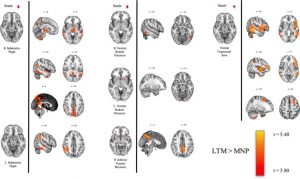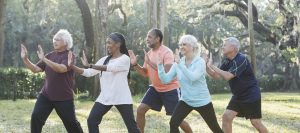Reduce Fear of Cancer Return with Mind-Body Practices
By John M. de Castro, Ph.D.
“the mind and body are really one entity, not two separate parts. Stated simply, there is no separation or division between the mind, body, spirit, and emotions. The best stress management program is one that moves you from fear toward peace, however you understand that concept.” – Health Encyclopedia
Receiving a diagnosis of cancer has a huge impact on most people. Feelings of depression, anxiety, and fear are very common and are normal responses to this life-changing and potentially life-ending experience. Coping with the emotions and stress of a cancer diagnosis is a challenge and there are no simple treatments for these psychological sequelae of cancer diagnosis. But over half of the people diagnosed with cancer are still alive 10 years later and this number is rapidly increasing. It is estimated that 15 million adults and children with a history of cancer are alive in the United States today. Cancer survivors are also at greater risk for developing second cancers and other health conditions and as a result fear of cancer recurrence is a major problem that can interfere with recovery. Hence there is a need to identify safe and effective treatments to reduce fear of cancer return.
Mindfulness training has been shown to help with cancer recovery and help to relieve chronic pain. It can also help treat the residual physical and psychological symptoms, including stress, sleep disturbance, fear, and anxiety and depression. There has been considerable research conducted on the effectiveness of mind-body practices in treating fear of cancer return. So it makes sense to step back and summarize what has been learned.
In today’s Research News article “Mind-body interventions for fear of cancer recurrence: A systematic review and meta-analysis.” (See summary below or view the full text of the study at: https://www.ncbi.nlm.nih.gov/pmc/articles/PMC6488231/), Hall and colleagues reviewed, summarized, and performed a meta-analysis of the published randomized controlled trials (RCTs) of the effects of mind-body practices on the fear of cancer recurrence. They included studies employing meditation, yoga, Tai Chi and Qigong, cognitive-behavioral skills, spirituality, relaxation, and various art therapies. They uncovered 18 published RCTs that included 2806 total participants.
They found that mind-body practices produced significant reduction in fear of cancer recurrence regardless of whether the comparison condition was an active control condition, whether the treatment occurred in group or individual format, whether the treatment contained cognitive behavioral skills or not, or whether the treatment contained meditation practice or not. These reductions were still present, albeit at reduced magnitude, up to 2 years after treatment.
Fear of cancer recurrence can produce behaviors that interfere with cancer recovery including increased stress, worry, rumination, etc. So, reducing this fear not only improves the psychological health of the patients but also improves their prognosis. These results suggest that mind-body are safe and effective, and have lasting effects reducing fear of cancer recurrence and thus should be incorporated in the treatments for patients recovering from cancer.
So, reduce fear of cancer return with mind-body practices.
“It is not usually possible for doctors to say for certain that your cancer has been cured. They can’t definitely say that it will never come back. Living with this uncertainty is one of the most difficult things about having cancer.” – Cancer Research UK
CMCS – Center for Mindfulness and Contemplative Studies
This and other Contemplative Studies posts are also available on Google+ https://plus.google.com/106784388191201299496/posts and on Twitter @MindfulResearch
Study Summary
Hall, D. L., Luberto, C. M., Philpotts, L. L., Song, R., Park, E. R., & Yeh, G. Y. (2018). Mind-body interventions for fear of cancer recurrence: A systematic review and meta-analysis. Psycho-oncology, 27(11), 2546–2558. doi:10.1002/pon.4757
Abstract
Objective
Fear of cancer recurrence (FCR) is a common existential concern and source of distress among adults with a cancer history. Multiple randomized controlled trials (RCTs) have examined mind-body approaches to mitigating FCR. We summarized characteristics of these trials and calculated their pooled effects on decreasing FCR.
Methods
Six electronic databases were systematically searched from inception to May 2017, using a strategy that included multiple terms for RCTs, cancer, mind-body medicine, and FCR. Data extraction and reporting followed Cochrane and Preferred Reporting Items for Systematic Reviews and Meta-Analyses (PRISMA) guidelines. Pooled effect sizes on self-report measures of FCR were computed by using random-effects models.
Results
Nineteen RCTs (pooled N = 2806) were included. Most studies (53%) were published since 2015 and targeted a single cancer type (84%; mostly breast). Intervention sessions (median = 6, mode = 4) tended to last 120 minutes and occur across 1.5 months. Delivery was predominantly in-person (63%) to either groups (42%) or individuals (42%). Most interventions incorporated multiple mind-body components (53%), commonly cognitive-behavioral skills (58%), or meditative practices (53%). Small-to-medium pooled effect sizes were observed post-intervention (Hedges’ g = −0.36, 95% CI = −0.49, −0.23, P < .001) and at follow-up assessments (median = 8 months, P < .001). Potential modifiers (control group design, group/individual delivery, use of cognitive-behavioral or mindfulness skills, number of mind-body components, cancer treatment status, and number of sessions) did not reach statistical significance.
Conclusions
Mind-body interventions are efficacious for reducing FCR, with small-to-medium effect sizes that persist after intervention delivery ends. Recommendations include testing effects among survivors of various cancers and exploring the optimal integration of mind-body practices for managing fundamental uncertainties and fears during cancer survivorship.
https://www.ncbi.nlm.nih.gov/pmc/articles/PMC6488231/









